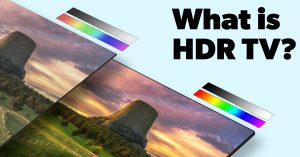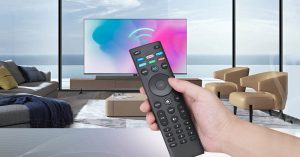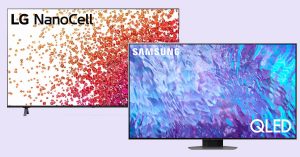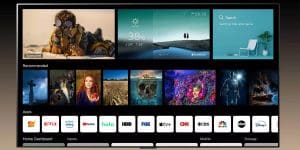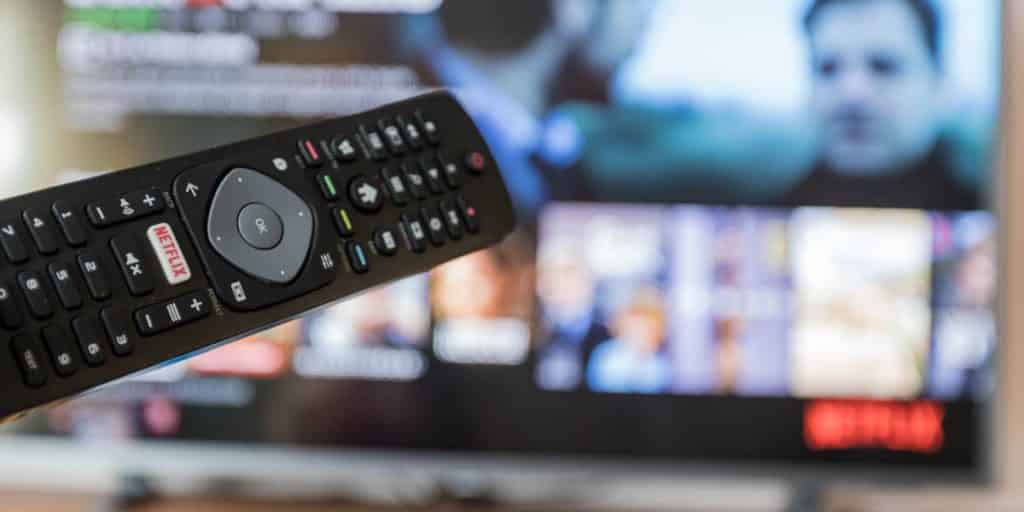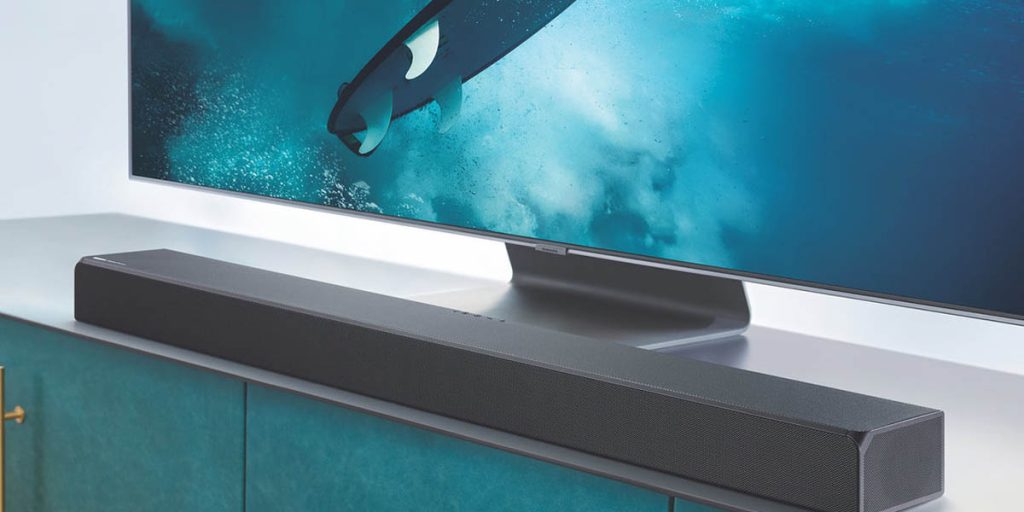How To Buy a New TV
When choosing a modern TV the buyer can get confused by all the features. You’d think that buying a TV would be a pretty straightforward experience. Every year, manufacturers update their lineup and introduce new technologies for TV.
Today, when buying a TV, you will encounter such names as Smart TV, UHD, OLED, QLED, HDR, etc. And in all of this, it is necessary to understand. What is a 4K TVs? Is OLED worth it? What about OLED vs. LED? And the biggie: what best TV should you buy?
Before choosing a new TV, you need to clarify a few things:
- Plasma panels are no longer available;
- There are no 3D TVs anymore;
- There are no Curved displays;
- All TV sets today have a flat screen and are up to 1 inch thick.
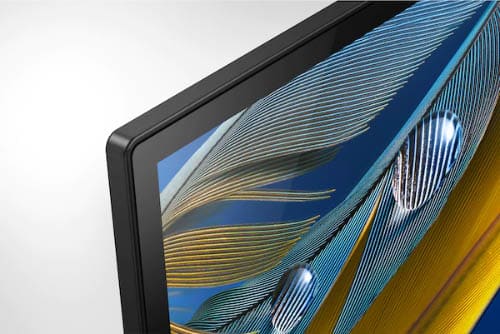
Special models are very thin so they can be mounted on the wall and do not have gaps. But you can hang any flat panel tv on the wall on a bracket. Wall mount means you don’t have to buy some giant piece of furniture to put the TVs on.
There are design models with an original design and with a display of famous paintings. These models are produced by Samsung.
Here are the 12 most important things to know when buying a TV.
Table of Contents
ToggleBuying a TV by Screen Technology
The development of television technology has led to the fact that today there are only two types of technology for the creation of displays on the market. These are LCD matrices on liquid crystals and expensive OLED panels.
LED or OLED
“LED” TV and “LCD” mean the same thing, only with a matrix backlit by LEDs. A liquid crystal matrix (LCD) requires backlighting. In the past, a fluorescent lamp was used for this, but now LEDs are used. LCDs consist of a layer of liquid crystals that block the flow of light from the backlight.
OLEDs consist of organic light-emitting diodes that turn on when the image on the display is formed and go out as the picture goes black.
To improve the image quality of LED displays, manufacturers have begun to use a layer of quantum dot color filters as part of the matrix to improve backlight quality. This gives greater color clarity on the screen.
Now there are models with better backlighting on miniLED. MiniLED is a very small LED that further improves backlighting compared to the old methods.
Samsung, Vizio, and TCL have these televisions called QLED, while LG has NanoCell. These screens have better color reproduction compared to conventional LEDs.
1) First place in terms of picture quality goes to OLED panels. Beautiful black on the image, good color reproduction, and better contrast. But they also come in first place in terms of price. The price for OLED TVs starts at $900.
2) In second place in terms of the picture are models with quantum dots. These are all the same liquid crystal displays (LCD), but with improved backlighting. The picture quality is good. The price starts from $500 for small diagonals (from 50 inches).
3) In third place is the most numerous and the most demanded group of LED TVs. Here is a large variety of models, which differ in the type of LED backlighting, screen size, and set of technologies. The price differs many times between the expensive and cheap models. Many buyers pay attention to this group.
Edge or Direct
For LED models, the backlighting is divided into Edge or Direct. With Edge, the LEDs are around the perimeter of the matrix (on the sides), and with Direct they are evenly distributed across the plane of the screen at the back.
Direct is considered better than Edge, it has more even backlighting and Direct can better organize the system of local dimming, which is necessary for HDR. An improved form of Direct backlighting is FALD (full-array local dimming).
With Edge backlighting, the TV is slimmer, but there will be uneven backlighting, less brightness, worse local dimming system.
With the good technical implementation of backlighting systems, all these disadvantages are barely noticeable when watching the video.
IPS or VA
A key point to consider if you decide to buy an LED TVs is how the LCD panel is lit, since this can have a big impact on the contrast the screen is capable of.
LED matrices can be assembled with IPS or VA technology.
Both types of the matrix are used equally. IPS has better viewing angles and more accurate color reproduction, while VA has better black level and contrast, which makes the colors in the picture look richer. It is easy to find the difference between the types of matrices on working TVs, only if both devices are side by side.
A comparison of IPS and VA technologies.
Look at the work of TV sets with different matrices in the store and make your decision. There is no definite advice. For viewing movies, VA is better because of better contrast and deeper blacks. For general TV sets, you can choose any matrix.
Screen Size and Diagonal
The size of the screen is determined by its diagonal. Thickness is small, but the width and height of the TVs are just calculated by the diagonal of the display. You need to know the dimensions to select the place of installation.
The diagonal is measured in inches, and this value can be found in the labeling of the TV itself or on the packaging. In the model name of the TV receiver, it is the first two digits that indicate the number of inches in the diagonal.
Typically, the second TV in the house is chosen with a diagonal of 32 — 43 inches.
In the living room are taken devices with a diagonal of 40 — 65 inches.
But for the organization of the home theater and choose TV sets with a diagonal of over 65 inches.
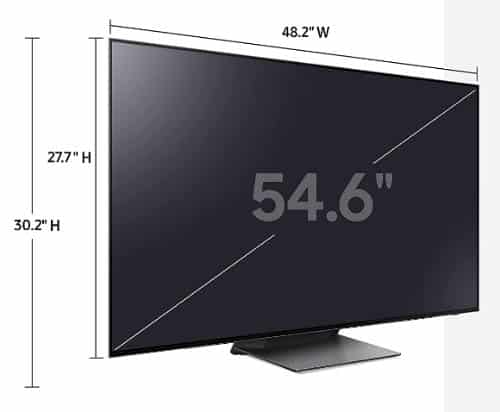
Recommendation! It is believed that you need to choose as big a diagonal screen in your TV, as your budget allows.
But this advice is important for those who like to watch a lot of movies on TVs, then you need a large size. This is the same principle in the movie theater, where the screen fills all of our peripheral vision.
And for watching just TV programs from the air, this rule is not necessary.
This is where the viewing distance is important, which is related to the resolution of the panel.
So how do you figure out the right size for you when it comes time to buy a TVs?
Screen Resolution
No TV buying guide would be complete without a discussion of the resolution.
Screen resolution shows how many dots (called pixels) are involved in shaping the picture on the display.
The higher the number of pixels, the clearer the picture. When comparing pictures with different resolutions you will immediately see the difference.
The standard range of screen resolutions:
- HD Ready (1366×768, 1280×720), HD (720p);
- Full HD (1920×1080), Full HD (1080p);
- Ultra HD 4K (3840×2160);
- Ultra HD 8K (7680×4320).
Today, manufacturers offer 4K (Ultra HD) displays if the diagonal size is larger than 40 inches. And that’s practically 70-80% of all models for every firm.
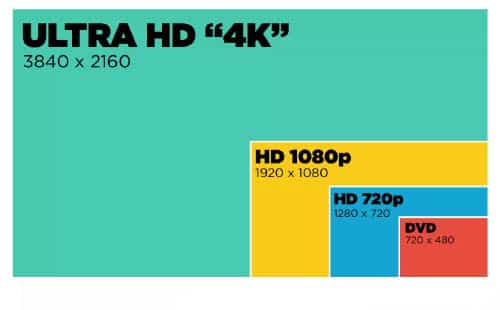
So if you choose a TV with a diagonal of 40″ or more, you will get a device with 4K resolution. With native 4K sources starting to become more common now and the prices of 4K TVs plummeting, we’d generally recommend that you buy a 4K TV.
TVs can also have Upscaling to 4K, which increases the original resolution to the desired 4K. Such a video will look better than the original, but it will not replace the real quality of Ultra HD.
Full HD resolution is found in models with diagonals of 24 to 43 inches in the lower ranges. Full HD televisions are significantly less expensive than the older 4K resolution series, and this is a good opportunity to save money. TVs with this resolution are bought as a second or third to the house.
HD Ready is found only in the most junior series models with a screen diagonal of up to 32 inches. This is the simplest and cheapest TV.
Ultra HD 8K is very rare, these are the flagships of companies that have taken the risk of releasing them. The main problem is there is no content with this resolution yet. Cost from $2,000. You can already buy higher resolution 8K TVs, but we suggest holding off.
Viewing Distance
Now that you have information about the diagonal of the display and its resolution, you can choose the exact distance from which you will watch TV.
It turns out that choosing this distance is a whole science. These calculations are made in cinemas or at home when installing a home theater. For a complete perception of the movie, take into account various little things.
It is believed that the more dots (pixels) form a picture on the screen, the closer you can sit to the TV. Now there is no such harmful radiation as there was in kinescopes. So you don’t have to be afraid of the close distance to the TVs but within reason.
The main thing is not to see individual pixels. And this is where the diagonal is taken into account. The bigger it is, the more pixels, which means you need to sit back so as not to see the pixelation of the image.
According to the simplest advice is that the viewing distance in the home should be 2-3 diagonals of the TV.
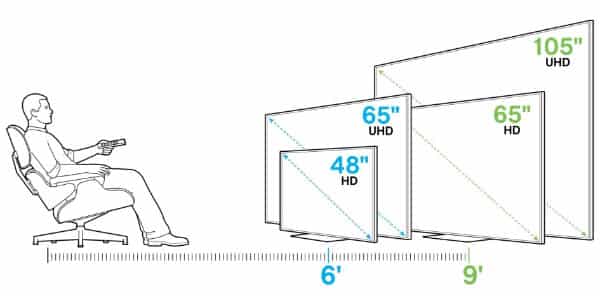
Picture Quality
The main thing on TV is still a picture on the display. The television receiver should reproduce it without interference and distortion. What flaws can modern TVs have in terms of picture quality?
The very first thing to check is the presence of broken pixels. As mentioned above, pixels make up the picture.
A pixel is a single dot on a display and consists of three subpixels of each color (blue, red, green). The combination of these colors can make a pixel glow in any color. Well, this is all science, and we need to know that a dead pixel is noticeable on the screen when you look at it.
To find dead pixels you need to fill the screen image with one of the colors, usually using a fill of black, white, red, blue, and green. On a monochrome image, look for dots of a different color at close range. If you find broken pixels already at home, the store may not accept your device back. These are basic test images, there are many more such test images.
You either have to find these one-color fills yourself on the Internet and take them with you to the store on a flash drive or there may already be such a function built into the TV menu.
The second thing you can check on the image is the overall impression of video quality. Turn on, for example, an over-the-air TV, then a high-definition clip. Look at the naturalness of the reproduced color. You can especially see it in the color of a person’s skin, green grass, blue sky, etc.
Smart TV
An important additional feature of modern TVs is the Smart TV system.
This functionality will help to connect your home multimedia devices to a single network. It will make it much easier to watch and listen to videos, photos, and music on your TV from other sources.

But this is just for convenience, and what is useful add-on Smart TVs is access to the Internet and search there for video content. To connect to the Internet, you can use the RJ-45 network cable connector or the built-in Wi-Fi module. In either case, install a router in the house that is connected to the Internet.
Every year, manufacturers update their Smart TVs systems, and today they replace its designation with the name of the operating system used. It is the operating system that serves to make the Smart TV work properly. For example:
- Samsung uses the Tizen operating system,
- Sony and Philips use Android TV,
- LG uses WebOS,
- Hisense, TCL use the Roku system,
- Panasonic developed the system itself (it used to use Firefox).
Almost all modern TVs come with Smart TV functionality. And only the younger series models may come without the operating system.
And remember, there are always external Smart TV set-top boxes that can replace the built-in system. Smart capability is now a standard feature in TVs, so it’s less and less of a factor in your buying decision.
If you’re ready to explore HDR and HDMI or just want tips on choosing the best TVs, keep reading our complete TV buying guide.
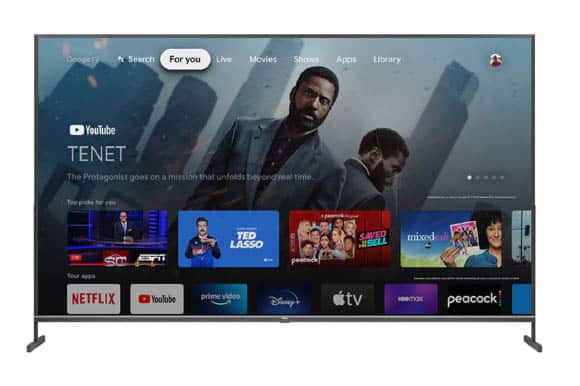
HDR
The extended dynamic range allows you to see more colors in the image in the dark or lightened areas, the image is richer and juicier.
HDR enhances picture quality. The dynamic range of an image indicates the difference between the brightest point in the picture and the darkest. This is a simple explanation rather for photography. For television, HDR increases the amount of color, improves contrast, and increases brightness.
There are several HDR formats: HDR10, HDR10+, HLG, and Dolby Vision. Different models of TVs have different sets of HDR formats, and several at once. There is competition between companies, and sometimes one manufacturer does not use the format of another. But you do not need to worry, your model will find the right format for High Dynamic Range.
The implementation of HDR requires the TVs to have advanced technology, and this is capable of the older models of the middle segment. Do not expect HDR quality from the cheapest models.
Frame Rate
The frame rate of the matrix itself is 60 Hz, and the high-end displays have a natural frequency of 120 Hz. 120 Hz has the advantage, but then the price is higher.
The frame rate affects the smoothness of the video on the screen. This effect can be seen in fast-moving videos and scenes, such as sports competitions.
Each company has its technology to increase the frame rate. These technologies work differently, and not always well. You need to check on the spot. The frequency value in such technologies can reach thousands of units.
Having a good artificial frame rate boost system improves video viewing. There are already ready clips from different movies by which you can check the quality of such a system. Watching such clips you will see the difference between TVs. The video should be smooth, without any jerks and crashes.
Connectors
Modern TVs usually has all the connectors you need. But it is worthwhile to check what you need.
The most used ones are USB and HDMI. They should preferably be four connectors each.
USB preferable version 3.0, at least one, the rest can be 2.0. All versions are compatible. The version affects the data transfer speed. You can connect a USB flash drive with video, camera, camcorder, etc. to a USB.
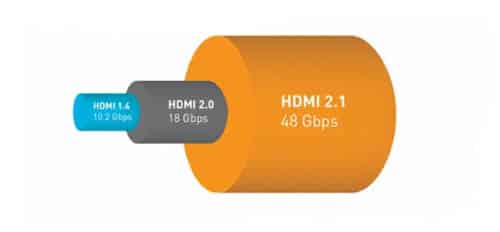
HDMI should be at least 2.0 because there can also be 1.4. HDMI is used to connect different set-top boxes, tuners, players, etc. Flagships already have HDMI 2.1. It’s good, if you have at least one such connector, now they are more needed for games.
What is the HDMI ARC connector on your TV?
The majority of TVs you buy now will come with built-in Wi-Fi. Wi-Fi is needed to connect devices wirelessly, such as a router to access the Internet.
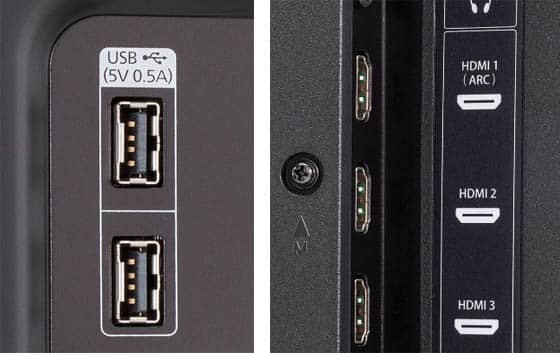
Tuner
To work you need such a digital tuner: ATSC 1.0. ATSC 3.0 will be better. Provides reception of terrestrial digital TV channels on the antenna.
The ATSC 3.0 system just evolving and not all communities have a signal, but for the future, it best to work with an ATSC 3.0 tuner.
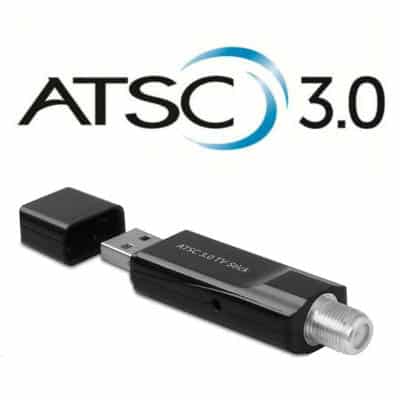
Sound
The sound quality of modern televisions is very different. Constructive difficulties because the body itself is flat and small in thickness complicate the task of obtaining quality sound. Putting quality speakers difficult in such a small design.
Therefore it is often advised to buy external acoustics, such as a home theater system, external stereo speakers with a subwoofer, and a soundbar.
It would be good if as part of the acoustics will be a separate bass and dialogue speaker.
It is impossible to get full-fledged decoding of DTS or Dolby Digital surround audio on the TVs. You need an external speaker. Especially when watching movies and concerts.
But technology goes forward and it’s better to check the sound quality when you buy the TV in the store, just in case the manufacturer made a good audio in the TVs.
Which company is better to buy a TV from?
It is impossible to recommend equipment of one brand only. They all normal. Every year, the model lineup of each manufacturer updated, and the mistakes of past models are corrected.
Of course, there are cases, when some firm has a bad lineup, but only this year, and next year everything will be fine. Or assemblers in some country screw up a bit. But then again it’s a few models of this year and only from this assembler. And in a few months, all will be fine.
On the forums, you can find arguments from owners of such models. And to figure out which one of them is right there is very hard.
Trust your eyes, check the device in the store, and read and watch reviews before buying if you don’t trust the stores.
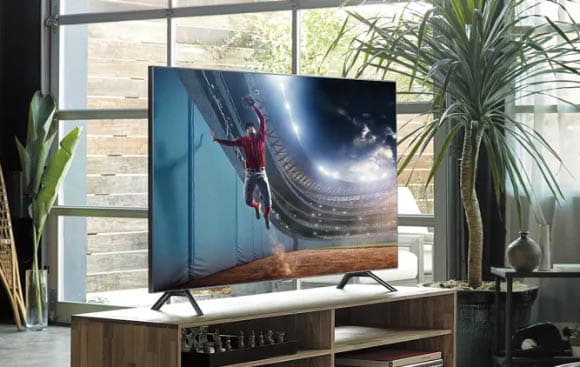
A General Algorithm For Choosing a TV
1) Before choosing a TV determine the amount of money and the location of the new TVs. Measure the height and width of the device at the place of installation and use the table to find the appropriate diagonal size in inches.
2) Choose what technology the display is made of, and what type of backlighting. This greatly affects the cost of the TV receiver.
OLED is the most expensive and with the best picture. This matrix is an organic LED, which emits light, so they are the best.
Next come quantum dot screens (QLED, NanoCell).
And the third group is the conventional LED screens. But here, too, there is a division into the premium segment and the ordinary. The cost can vary several times. It is better to determine these technologies at home.
You can refer to the displays and the frame rate, 60 or 120 Hz. 120 Hz screens are noticeably better.
3) Choose the screen diagonal of the TV, taking into account the installation location and viewing distance.
4) Now you need to choose the resolution of the TV. There is not much choice here.
If you are a big fan of new technology and you have enough money, you can choose 8K.
But most buyers will buy 4K because this is the largest segment on the market.
5) If you choose a TVs in a real store, it’s worth paying attention to the features that you can’t check online. Ask to turn it on and check the panel for broken pixels and color quality. Additionally, check the sound quality.
6) The tuner and connectors will probably be what you need. Just check the HDMI and USB versions on the datasheet, and the general availability of connectors if you are going to connect a lot of equipment.
7) Smart TV is identified in the TV’s datasheet by the operating system used. Most modern TVs have an operating system. Only the youngest series may not have one.
8) HDR function, which will improve the picture if the picture itself is in HDR format. To get a TV with this feature, look at the basic specifications of the unit.
Use this TVs buying guide to get the good TV.
Author
-
Author of articles on tvrvi.com. I know all the TV industry news and spend a lot of time to research TV technology.

